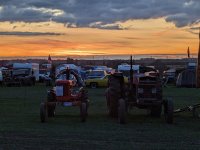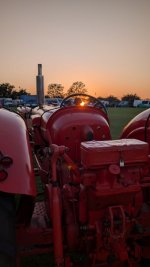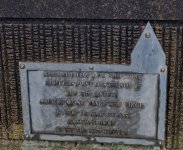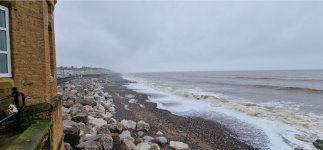You are using an out of date browser. It may not display this or other websites correctly.
You should upgrade or use an alternative browser.
You should upgrade or use an alternative browser.
One for the tractor 🚜 lovers.
- Thread starter runnach
- Start date
mistericeman
Full Member
- Messages
- 796
In 1939, David Brown & Sons acquired the former United Thread Mills factory at Meltham, on the south side of Huddersfield. Brown, who also owned a farm, started the Ferguson-Brown Company in 1936, building tractors with Harry Ferguson in a corner of Park Gear Works; however, they disagreed over design details, which led David Brown to design his own version, the David Brown VAK1, which was introduced to the market in 1939, with over 7,700 units eventually sold. Harry Ferguson went to America and did a deal with Henry Ford to incorporate his system in the Ford N-Series tractor, before setting up Ferguson Tractors.Another one I did 2 years earlier, unfortunately I have sold this one.
Both were built 3 miles from where I live
View attachment 76075
The Second World War saw a massive increase in the production of gears and gearboxes by David Brown Ltd for use in military equipment. The rising income from the company's traditional products and the manufacture of tractors made Brown a wealthy man.
In late 1946, Brown saw a classified advertisement in The Times offering for sale a "High Class Motor Business". The asking price was £30,000.On inquiring further Brown discovered that the company was Aston Martin. A few days later Brown visited the company's headquarters at Feltham and test drove their new prototype design, the Atom.
While he felt it had good road handling he considered that its 2.0 litre four cylinder pushrod engine lacked power. However, seeing its potential, he entered into negotiations which ended in February 1947 with his acquiring the company for £20,500. Following the purchase, work began on converting the Atom into a production car. While the prototype was a saloon, Brown preferred convertibles so the chassis was redesigned to accommodate an open top.Eventually it entered production as the Aston Martin 2-Litre Sports, now commonly called the DB1.
mistericeman
Full Member
- Messages
- 796
I quite like this one though
runnach
Full Member
- Messages
- 3,339
A
AWESOMEI quite like this one though
runnach
Full Member
- Messages
- 3,339
Interesting history. Feltham brought back a long lost memory though, Part two of my job interview with Eutectic + Castolin at Feltham, sitting in an office viewing aircraft taking off from Heathrow. Part one interview held in Edinburgh.In 1939, David Brown & Sons acquired the former United Thread Mills factory at Meltham, on the south side of Huddersfield. Brown, who also owned a farm, started the Ferguson-Brown Company in 1936, building tractors with Harry Ferguson in a corner of Park Gear Works; however, they disagreed over design details, which led David Brown to design his own version, the David Brown VAK1, which was introduced to the market in 1939, with over 7,700 units eventually sold. Harry Ferguson went to America and did a deal with Henry Ford to incorporate his system in the Ford N-Series tractor, before setting up Ferguson Tractors.
The Second World War saw a massive increase in the production of gears and gearboxes by David Brown Ltd for use in military equipment. The rising income from the company's traditional products and the manufacture of tractors made Brown a wealthy man.
In late 1946, Brown saw a classified advertisement in The Times offering for sale a "High Class Motor Business". The asking price was £30,000.On inquiring further Brown discovered that the company was Aston Martin. A few days later Brown visited the company's headquarters at Feltham and test drove their new prototype design, the Atom.
While he felt it had good road handling he considered that its 2.0 litre four cylinder pushrod engine lacked power. However, seeing its potential, he entered into negotiations which ended in February 1947 with his acquiring the company for £20,500. Following the purchase, work began on converting the Atom into a production car. While the prototype was a saloon, Brown preferred convertibles so the chassis was redesigned to accommodate an open top.Eventually it entered production as the Aston Martin 2-Litre Sports, now commonly called the DB1.
Cheers..........
Undertaker
Full Member
- Messages
- 181
Bottom right is a Nuffield, I recognise that offset for ploughing steering wheel and rubber bung seat suspension anywhere 
Undertaker
Full Member
- Messages
- 181
And it's a live drive
Undertaker
Full Member
- Messages
- 181
I'll get my anorak 
rugbyken
Full Member
- Messages
- 1,622
my cousin has worked the fields since schooldays & he’s older than me lol until recently he had a 1958 john deere tractor that had been imported from germany before you could get one in the uk , for many years he used to take it to shows and he transported it on a commer dropside truck of the same vintage until a few years ago just when he was finding it a bit much someone at a show offered him what he thought of as silly money for his whole set up job done
Exwindsurfer
Full Member
- Messages
- 4,412
I was there last weekOR these beauties at Withernsea over on the East Coast near hull .
View attachment 76071View attachment 76072
mistericeman
Full Member
- Messages
- 796
Exwindsurfer
Full Member
- Messages
- 4,412
Yes we found everybody very friendly we were stopping in a cottage at GartonOne of my fave east coast spots to visit ...
Always a chilled out vibe with,friendly folks
Great fish and chips/cafes etc etc .
And always seems friendly to visitors .
View attachment 76091View attachment 76092View attachment 76093
mistericeman
Full Member
- Messages
- 796







